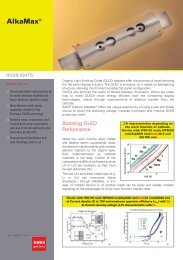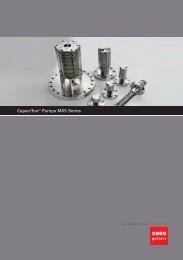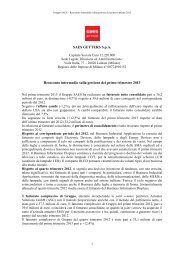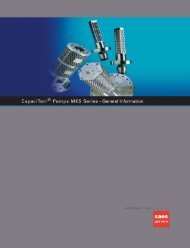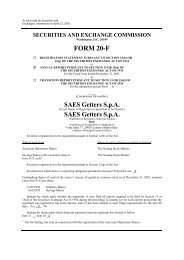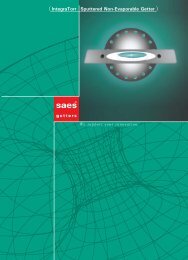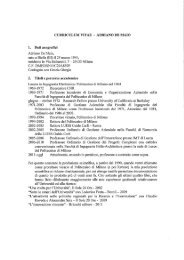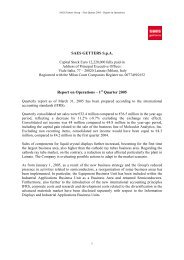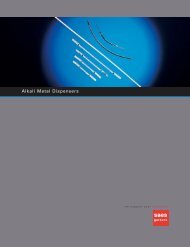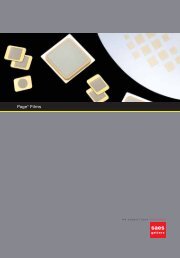sorb ac general.pdf - SAES Getters
sorb ac general.pdf - SAES Getters
sorb ac general.pdf - SAES Getters
- No tags were found...
You also want an ePaper? Increase the reach of your titles
YUMPU automatically turns print PDFs into web optimized ePapers that Google loves.
SORB-AC ® Cartridge Pumps MK5 Serieswe support your innovation
SORB-AC ® Cartridge Pumps - MK5 SeriesGENERAL INFORMATIONSORB-AC MK5 Series Cartridge Pumps, a type of v<strong>ac</strong>uum pump manuf<strong>ac</strong>tured by <strong>SAES</strong> <strong>Getters</strong> S.p.A.,<strong>sorb</strong> <strong>ac</strong>tive gases with a nonevaporable getter (NEG) material. They are used alone or in combinationwith other v<strong>ac</strong>uum pumps in several applications in high and ultrahigh v<strong>ac</strong>uum (HV and UHV).WORKING PRINCIPLESThe pumping process <strong>sorb</strong>s by chemical re<strong>ac</strong>tion <strong>ac</strong>tive gas molecules impinging on the clean metalsurf<strong>ac</strong>e of e<strong>ac</strong>h particle of the getter material contained in the pump cartridge. A clean metal surf<strong>ac</strong>emeans a metal surf<strong>ac</strong>e not covered by oxide or carbide layers which result when the getter materialis exposed to air during manuf<strong>ac</strong>turing, installation or air venting steps.The method used to obtain this clean metal surf<strong>ac</strong>e distinguishes non-evaporable getter pumps fromothers: the getter material does not need to be evaporated, as does titanium in a titanium sublimationpump. It only needs to be heated, under dynamic v<strong>ac</strong>uum, to diffuse the passivation layer coveringthe surf<strong>ac</strong>e of e<strong>ac</strong>h getter particle into the bulk of the getter material. The passivation layer consistsmainly of oxides and carbides. This heat treatment, called <strong>ac</strong>tivation, enhances the kinetics of thisdiffusion process, which is negligible at room temperature.The getter material maintains its original configuration of metal particles coated on a substrate. The<strong>ac</strong>tivation process is illustrated schematically in Figure 1, in which a single getter particle is considered.H 2OH 2 OpassivatinglayerH 2In<strong>ac</strong>tiveNEGparticleH 2O 2N 2 COHEATV<strong>ac</strong>uumorInert GasActiveNEGparticleO 2CON 2Figure 1 - Schematic representation of the <strong>ac</strong>tivation process for NEG.GETTER MATERIALSThe getter material used in the SORB-AC cartridge pumpsMK5 series is a Zr-V-Fe alloy with the trade name St 707,manuf<strong>ac</strong>tured by <strong>SAES</strong> <strong>Getters</strong> S.p.A. 1This alloy pumps all the <strong>ac</strong>tive gases and is especiallyefficient in pumping hydrogen and its isotopes. The<strong>ac</strong>tive gases are permanently <strong>sorb</strong>ed. Hydrogen and itsisotopes form solid solutions in the alloy. Hydrogen andits isotopes can be removed from the alloy in <strong>ac</strong>cordancewith Sieverts' Law.St 707 alloy is a getter material with superior diffusivitychar<strong>ac</strong>teristics. This allows St 707 to be fully <strong>ac</strong>tivatedat temperatures in the range of 350-450°C. Figure 2illustrates the surf<strong>ac</strong>e composition as a function of theheating treatment (about 10 minutes) on the alloy. Thelow <strong>ac</strong>tivation temperature often makes St 707 thepreferred alloy by most users.1 . The Zr-Al alloy (trade name St 101), is available only for the GP 50 andGP 100 pump models. If an St 101 cartridge is required for the GP 200or GP 500 pump models it is necessary to order the correspondingpumps of the MK4 series.Surf<strong>ac</strong>e Composition (AT %)100908070605040302010Temperature (°C)Zr - V - FeCVO0 200 400 600 800 1000Figure 2 - NEG surf<strong>ac</strong>e composition vs<strong>ac</strong>tivation temperature (Ref. K. Ichimura, et al. J.V<strong>ac</strong>. Sci. Technol. A5 (2) (1987) 220)ZrWe support your innovation1
PUMPING CHARACTERISTICSBehavior of the getter materialsIt is possible to identify four main families of gases with respect to their inter<strong>ac</strong>tion with gettermaterials. The first family consists of hydrogen and its isotopes, which are <strong>sorb</strong>ed reversibly. Thesecond family consists of other <strong>ac</strong>tive gases such as CO, CO 2, O 2 and N 2, which are <strong>sorb</strong>ed irreversibly.The third family consists of gases which are <strong>sorb</strong>ed in a combination of the two above described wayssuch as water and hydrocarbons. The fourth family consists of rare gases, which are not <strong>sorb</strong>ed bythe getter materials.HydrogenHydrogen does not form a stable compound with the getter alloy but diffuses rapidly into the bulkof the <strong>ac</strong>tive material, where it is stored as a solid solution. A given concentration of hydrogen insidethe getter alloy corresponds to an equilibrium pressure of hydrogen, which is strongly dependent ontemperature. This dependence is described by Sieverts' Law, given by the following expression:Where:Log P = A +2 Log q - B Tq = is the concentration, in liter•Torr/gram of alloyP = is the equilibrium pressure, in TorrT = is the getter temperature, in KA = 4.8 for St 707 alloyB = 6116 for St 707 alloySORB-AC pumps can be used as heat controlled reversible pumps, which pump hydrogen at lowtemperature and release it at high temperature. The equilibrium curves for the St 707 alloy are shownin Figures 3.10 0St 707Hydrogen Equilibrium Pressure (Torr)10 -210 -410 -610 -8500°C400°C300°C200°C600°CEmbrittmement Lilmit (20 Torr I/g)10 -10 10 -2 10 -1 10 0 10 1Hydrogen Concentration (Torr I/g)Figure 3 - Hydrogen equilibrium pressure for the St 707 alloyOther Active GasesOther <strong>ac</strong>tive gases such as carbon monoxide, carbon dioxide, nitrogen and oxygen are chemi<strong>sorb</strong>edirreversibly by the getter material. The chemical bonds of the gas molecule are first broken on thesurf<strong>ac</strong>e of the getter and then the constituent elements are <strong>sorb</strong>ed as atoms, forming oxides, carbidesand nitrides. The strength of the chemical bonds between the getter and these elements is so strongthat even if the getter material is heated to temperatures of the order of 1000°C, no gases are releasedinto the v<strong>ac</strong>uum environment. On the contrary, high temperature treatments promote the diffusionof the gas species into the bulk of the getter material, cleaning the surf<strong>ac</strong>e for further sorption.We support your innovation2
Water Vapor and HydrocarbonsWater vapor and hydrocarbon chemical bonds are cr<strong>ac</strong>ked on the surf<strong>ac</strong>e of the getter material.Hydrogen, oxygen and carbon are then <strong>sorb</strong>ed as explained above. However, sorption efficiency ofhydrocarbons at temperatures under 500°C is very low.Rare GasesGetter materials do not <strong>sorb</strong> rare gases. SORB-AC non-evaporable pumps can therefore be used toremove impurities of <strong>ac</strong>tive gases in rare-gas filled devices.Pumping PerformancesDue to the working principle of getter materials and their typical behavior toward different gas families,the pumping performance (pumping speed and gettering cap<strong>ac</strong>ity) of SORB-AC pumps depends onthe type of gas <strong>sorb</strong>ed and the temperature of the getter cartridge. The pumping performance of SORB-AC pumps are measured <strong>ac</strong>cording to the ASTM standard F798-82, which specifically refers tononevaporable getter devices. The procedure is an application of the dynamic-flow method, also usedfor measurements in other standards. The test is carried out at constant pressure over the getterdevice. It is important to notice that the testing pressure does not affect the pumping speed of thepump when the pressure is below 10 -5 Torr.10000Pumping Speed (I/s)1000H 2 - 25°CH 2 O - 280°CH 2 - 280°CCO - 280°C100H 2 O - 25°CCO - 25°C100.01 0.1 1 10 100 1000Sorbed Quantity (Torr I)Figure 4 - Typical pumping speed curves of a SORB-AC cartridge pumpIn Figure 4, the pumping speed curves of a getter pump for H 2, CO and H 2O are shown. The pumpingspeed value is plotted versus the quantity of gas <strong>sorb</strong>ed during the test. As mentioned above, it wouldbe meaningless and misleading to plot it versus the pressure as in sputter ion pumps. The differentsorption mechanisms of the getter material towards H 2 (high diffusion rate both at high and roomtemperature) and CO (low diffusion rate at room temperature, high diffusion rate at high temperature)are also evident in the curves.The effect of the diffusion phenomena for the sorption of CO is interesting to note. When diffusionis not present, i.e. operating at room temperature, only the surf<strong>ac</strong>e of the getter is available for thesorption of the gas. Therefore the cap<strong>ac</strong>ity is limited and the pumping speed drops to low valueswhen the surf<strong>ac</strong>e becomes saturated. In this case, many re<strong>ac</strong>tivations will be necessary to use thetotal cap<strong>ac</strong>ity of the getter cartridge. When diffusion is present, (i.e. operating at high temperature),the bulk of the getter material is available for gas sorption. The cap<strong>ac</strong>ity for a single <strong>ac</strong>tivation processis much larger and an almost constant value of the pumping speed is maintained for a much longertime. There is not a big difference in sorption performance of H 2 at different operating temperaturesdue to the high diffusivity of this gas even at room temperature, and unlike CO, the cap<strong>ac</strong>ity is reducedwhen operating at high temperature due to the high equilibrium pressure.The sorption of water vapor is preceded by the dissociation of the water molecule on the getter surf<strong>ac</strong>e,and is limited by the cap<strong>ac</strong>ity of the alloy for O 2, while H 2 diffuses quickly into the bulk of the gettermaterial.Oxygen and nitrogen in the bulk diffusion regime are <strong>sorb</strong>ed with pumping speeds of approximately:65% (O 2) and 15% N 2) of the sorption speed of H 2.Hydrocarbons are <strong>sorb</strong>ed only at elevated temperatures and with very low efficiency. A pumpingspeed for CH 4 of about 0.5% of the speed for CO is observed at 500°C.We support your innovation3
Activation of SORB-AC Cartridge PumpsAs previously mentioned, the nonevaporable getter material used in the getter cartridges developsits pumping char<strong>ac</strong>teristics after an <strong>ac</strong>tivation process, i.e., after being heated to a suitably hightemperature under dynamic v<strong>ac</strong>uum for an appropriate time. The heat treatment diffuses the thinprotective layer that is formed on the surf<strong>ac</strong>e of the getter particles by air exposure during manuf<strong>ac</strong>ture.Diffusion of this layer into the bulk makes the surf<strong>ac</strong>e of the getter clean and able to <strong>sorb</strong> the gasmolecules of the v<strong>ac</strong>uum system in which it is operated. The efficiency of this <strong>ac</strong>tivation process isrelated to the diffusion coefficient of the specific getter material, which in turn depends on an exponentialfunction of the temperature:D = D 0exp (- E/T). It is also related to the square root of time, as with all the diffusion processes.In first approximation, the <strong>ac</strong>tivation efficiency, considered related to the quantity of passive speciesremoved from the surf<strong>ac</strong>e of the getter particles, can be expressed by the following formula:Activation efficiencyFigure 5 gives the suggested time/temperature combinations for the best (100%) <strong>ac</strong>tivation for St 707(450°C for 45 minutes) alloy based cartridges. The curves show that a shorter <strong>ac</strong>tivation must becompensated by a higher temperature <strong>ac</strong>tivation in order to obtain the same final efficiency and viceversa. Both these parameters are limited by pr<strong>ac</strong>tical and physical constraints to the range of valuesindicated in the figure.∞Dt800Melting Area of the Constantan Strip700Activation Temperature (°C)600500400300200★100%60%St 707 ®100★ Standard Activation Conditions10 100 1000Activation Time (Minutes)Figure 5 - Activation efficiency for St 101 and St 707 alloysHowever, in pr<strong>ac</strong>tical cases it is not always possible to use the "ideal" time/temperature combinations.Suitable operation modes can be chosen where only a "partial" <strong>ac</strong>tivation is considered sufficient.This results in a condition where the getter surf<strong>ac</strong>e develops less than full pumping speed. Activationconditions giving 60% of the optimum pumping speed are also shown in Figure 5. The <strong>ac</strong>tivationprocess should be carried out after a pump down of the v<strong>ac</strong>uum system to a pressure of 10 -4 Torr orless. After having re<strong>ac</strong>hed this pressure, the heater can be energized to re<strong>ac</strong>h the desired <strong>ac</strong>tivationtemperature.During the heating phase gases de<strong>sorb</strong> from the getter cartridge. This is due to the physi<strong>sorb</strong>ed gaseswhich form the external monolayers covering the surf<strong>ac</strong>e of the getter material, while the internalchemi<strong>sorb</strong>ed layers are diffused into the bulk of the getter material.De<strong>sorb</strong>ed gases initially include H 2, H 2O, CO, CO 2, CH 4, and eventually mainly H 2, due to the behaviorof the getter material toward this gas. Baking the system with the getter cartridge maintained at atemperature relatively higher than the other components of the system has been found to be effectiveway to minimize this gas evolution. This procedure minimizes the migration of the gases de<strong>sorb</strong>edfrom the wall of the system toward the getter cartridge, which has a real surf<strong>ac</strong>e area much largerthan the system walls themselves.We support your innovation4
During <strong>ac</strong>tivation it is advisable not to exceed pressures in the 10 -3 Torr range to avoid phenomenaof corrosion of the heater wire, RF discharges between the heater and other pump elements andcontamination of the gettering material due to the sorption of <strong>ac</strong>tive gases during the <strong>ac</strong>tivationprocess.For this purpose, and depending on the pumping speed of the b<strong>ac</strong>king pump, it may be advisable to<strong>ac</strong>tivate the getter cartridge by successive steps, not applying the full power to the heater at thebeginning of the <strong>ac</strong>tivation process. In this case, re<strong>ac</strong>hing the <strong>ac</strong>tivation temperature may take a fewhours compared to 30 minutes usually needed if full power is applied at the beginning.Operation of SORB-AC Cartridge PumpsWhen <strong>ac</strong>tivated, the SORB-AC cartridge pump can be operated at various temperatures <strong>ac</strong>cording tothe load of <strong>ac</strong>tive gases, taking into <strong>ac</strong>count two main f<strong>ac</strong>ts. First, the higher the temperature, thehigher the diffusivity of the <strong>sorb</strong>ed gases into the bulk of the getter material. Second, the higher thetemperature, the higher the H 2 equilibrium pressure. High temperature operation is preferred whenhigh gas loads are present. In this way it is possible to maintain a high diffusion rate and consequentlya constant pumping speed for all the <strong>ac</strong>tive gases.Temperatures in the range of 280°C are typically suggested for St707, but different values can beadopted. High getter temperature is usually not compatible with UHV operation due to the desorptionof hydrogen from the getter material. For example the use of an St 707 cartridge at 280°C will causean initial hydrogen equilibrium pressure on the getter material in the range of 10 -7 - 10 -8 Torr due tothe residual H 2 content of the alloy and depending on the presence of additional pumping devices.Room temperature operation is indicated when the gas load is low, and for the reason mentionedabove, it is mandatory when the operating pressure is below 10 -8 Torr. When pumping high purityhydrogen, operation at room temperature is also possible with high gas loads due to the high diffusivityof H 2 at that temperature. In this latter case, a careful evaluation of the gas load and of the quantityof gas <strong>sorb</strong>ed is necessary to avoid possible embrittlement.Note that in the curves in Figure 3, the <strong>ac</strong>tual concentration of H 2 in the alloy (and therefore the residualcap<strong>ac</strong>ity) to be known before embrittlement occurs can be determined by a simple measurement ofthe pressure in static v<strong>ac</strong>uum at a given operating temperature.Re<strong>ac</strong>tivation of SORB-AC Cartridge PumpsThe re<strong>ac</strong>tivation of the getter cartridge of a SORB-AC pump is necessary when the cartridge is exposedto air or when it’s pumping speed falls below <strong>ac</strong>ceptable limits. In both cases the surf<strong>ac</strong>e of the gettermaterial becomes covered by a passivation layer of mainly carbides and oxides. If re<strong>ac</strong>tivation ispreceded by an air exposure (and a successive pump down cycle), it should follow the same procedureand has the same char<strong>ac</strong>teristics of the first one. If the re<strong>ac</strong>tivation follows normal in-v<strong>ac</strong>uum operationwithout air venting, it may be shorter and carried out at a lower temperature (indicatively 25% lower).Moreover during a re<strong>ac</strong>tivation which follows normal in-v<strong>ac</strong>uum operation the only gas released ishydrogen. Through successive re<strong>ac</strong>tivations it is possible to use the entire cap<strong>ac</strong>ity of the gettermaterial. When the pumping speed no longer recovers sufficiently after re<strong>ac</strong>tivation, the cartridgemust be repl<strong>ac</strong>ed.Regeneration of SORB-AC Cartridge PumpsHydrogen and hydrogen isotopes <strong>sorb</strong>ed by the cartridge can be released from the getter materialthrough a regeneration treatment. Regeneration is necessary when:••the pumping speed for hydrogen or hydrogen isotopes has fallen below <strong>ac</strong>ceptable limits becausethe equilibrium pressure has been appro<strong>ac</strong>hed.equilibrium is far from being re<strong>ac</strong>hed but the hydrogen or hydrogen isotopes quantity pumped isappro<strong>ac</strong>hing the embrittlement limit of 20 liter Torr/g.Embrittlement of the material takes pl<strong>ac</strong>e when the quantity of hydrogen <strong>sorb</strong>ed in the getter materialis high enough to modify the mechanical char<strong>ac</strong>teristics of the alloy causing it to flake into smallparticles from the substrate. The process of hydrogen sorption and successive desorption (regeneration),can be visualized on the Sieverts’ plots of the specific alloy (see Figure 6).The temperature increase of the getter alloy establishes a high hydrogen equilibrium pressure, allowinghydrogen removal by means of a standard b<strong>ac</strong>king pump. From the plot in Figure 5 can see that theregeneration process will be more effic<strong>ac</strong>ious at higher temperature.We support your innovation5
P (Torr)DesorptionT 2T 1▼)(The time necessary for the regenerationof a cartridge is given by the expression:t =M F(1 1q fq i10A B T)▼Sorptionq f q iT 1= sorption temperatureT 2= regeneration temperatureq (Torr•l/g)Figure 6 - Regeneration CycleWhere:t = is the regeneration time, in secondsM = is the mass of the getter material, in gramsF = is the pumping speed of the b<strong>ac</strong>king pumps in, liter/sq f = is the final H 2concentration, in liter Torr/gq i = is the initial H 2concentration, in liter Torr/gA = 4.8 for St 707 alloy cartridgesB = 6116 for St 707 alloy cartridgesT = is the regeneration temperature in KDue to the exponential shape of the regeneration curve, a significant amount of time is saved whenthe regeneration is not programmed to be complete (where 100% of the <strong>sorb</strong>ed hydrogen is released)but only partial (for example 90%). Thus if a given amount of hydrogen must be <strong>sorb</strong>ed in e<strong>ac</strong>h cycle(for instance 10 liter Torr/g) it is much better to operate using q f= 2; q i= 12 than using q f= 0; q i= 10.SPECIAL INSTRUCTIONSThermal Fatigue1000The re<strong>ac</strong>tivation and regeneration processescan be performed many, but not an infinitenumber of times. Due to thermal fatigue inthe getter-coated strips, peel-off of thegettering powder eventually occurs, whichmainly depends on the temperature and onthe duration of the heating process. Figure 7shows the number of permissible thermalcycles, at 700°C, 600°C and 500°C as a functionof the hold time before peel-off starts to occur.Cycles Before Initial Peel-Off900800700600500400300200700° C600°C500° C100Figure 7 - Thermal Fatigue Effects on NEG Strip00 15 30 45 60 75 90 105 120Hold Time (Minutes)We support your innovation6
Air VentingOpening the v<strong>ac</strong>uum chamber where MK5 SORB-AC pumps are mounted should be performed onlywhen the getter material is at room temperature or at least below 50°C. After e<strong>ac</strong>h air exposure, anew re<strong>ac</strong>tivation of the getter cartridge is required.A progressive reduction of pumping speed for hydrogen and <strong>ac</strong>tive gases is observed after successiveexposures to air. After about 30 air exposures at room temperature followed by re<strong>ac</strong>tivation, St 707cartridges at 280°C still have a pumping speed for hydrogen of about 40% of the original pumpingspeed.If dry nitrogen is used instead of air, the pumping speed reduction after the same number of exposures,appears to be lower (residual pumping speed still about 80% of the initial value, see Figure 8). Thisis because, for the first cycles, the effect of the re<strong>ac</strong>tivation which follows a nitrogen exposure isgreater than the new contamination caused by exposure to nitrogen. Further improvement is obtainedwhen pure argon is used as a protective gas during maintenance operations.120Percentage of Initial Pumping Speed10080604020NitrogenAir00 5 10 15 20 25 30 35Number of ExposuresFigure 8 - effects of air and N 2 exposuresV<strong>ac</strong>uum Failure During Activation or RegenerationDuring <strong>ac</strong>tivation or regeneration of SORB-AC cartridge pumps, air must not be allowed to suddenlyenter the v<strong>ac</strong>uum system. Such an occurrence could cause burning, i.e. a quick oxidation, of thecoated strip. This happens if the temperature of the cartridge at the moment of v<strong>ac</strong>uum failure isabove 200°C in the case of St 707 cartridges. The burning is slow and progressive, not explosive.Should a serious v<strong>ac</strong>uum failure take pl<strong>ac</strong>e when the temperature of the cartridge is high, althoughbelow the above-indicated values, permanent damage of varying degrees will occur <strong>ac</strong>cording totemperature, but not burning. In this case, pumping char<strong>ac</strong>teristics of the getter material would beaffected to a greater or lesser extent depending on temperature and time. Also, in these cases, a moreefficient recovery of gettering efficiency can be obtained by using a re<strong>ac</strong>tivation procedure at atemperature higher than the normally adopted value.Excessive Heating of the CartridgeThe St 707 cartridges use constantan as a substrate material, and they should not be heated totemperature over 750°C to avoid possible copper or manganese evaporation from the material. Attemperatures over 850°C, it is possible to have the formation of eutectic compounds between copperand zirconium, which could cause melting of the cartridge.Mechanical ShocksDue to the mechanical char<strong>ac</strong>teristics of the insulating elements of the heater (ceramic sp<strong>ac</strong>ers),particular care must be observed in handling during assembly (and removal) of the pumping system.Accidental dropping and similar mechanical shock could result in breakage of the insulating elementswith possible short circuits of the electrical path.We support your innovation7
E.VS.03.02The <strong>SAES</strong> <strong>Getters</strong> Group manuf<strong>ac</strong>turing companies are ISO9001 certified, the Asian and Italian companies are ISO14001certified also. Full information about our certifications for e<strong>ac</strong>h company of the Group is available on our website at:www.saesgetters.com© 2002 <strong>SAES</strong> <strong>Getters</strong>. Printed in Italy. All rights reserved. <strong>SAES</strong> ® is registered trademark of <strong>SAES</strong> <strong>Getters</strong> S.p.A., its subsidiaries and affiliates.<strong>SAES</strong> <strong>Getters</strong> reserves the right to change or modify product specifications at any time without notice.<strong>SAES</strong> <strong>Getters</strong> Groupwww.saesgetters.comneg_technology@saes-group.com



